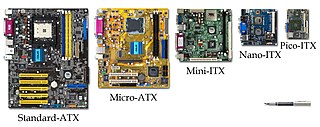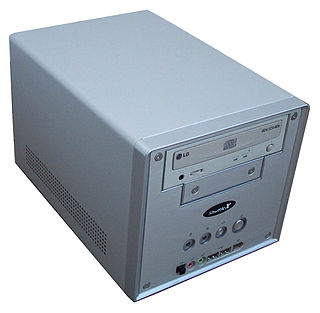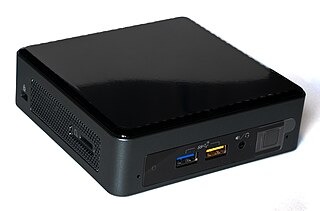Related Research Articles

VIA Technologies Inc., is a Taiwanese manufacturer of integrated circuits, mainly motherboard chipsets, CPUs, and memory. It was the world's largest independent manufacturer of motherboard chipsets. As a fabless semiconductor company, VIA conducts research and development of its chipsets in-house, then subcontracts the actual (silicon) manufacturing to third-party merchant foundries, such as TSMC.

ATX is a motherboard and power supply configuration specification developed by Intel in 1995 to improve on previous de facto standards like the AT design. It was the first major change in desktop computer enclosure, motherboard and power supply design in many years, improving standardization and interchangeability of parts. The specification defines the dimensions; the mounting points; the I/O panel; and the power and connector interfaces among a computer case, a motherboard, and a power supply.

Mini-ITX is a 17 × 17 cm (6.7 × 6.7 in) motherboard form-factor, developed by VIA Technologies in 2001. They are commonly used in small-configured computer systems. Originally, they were a niche product, designed for fan-less cooling with a low power consumption architecture, which made them useful for home theater PC systems, where fan noise can detract from the cinema experience. The four mounting holes in a Mini-ITX board line up with four of the holes in ATX-specification motherboards, and the locations of the backplate and expansion slot are the same. Mini-ITX boards can therefore often be used in cases designed for ATX, micro-ATX and other ATX variants if desired.

A computer case, also known as a computer chassis, is the enclosure that contains most of the components of a personal computer. Cases are usually constructed from steel, aluminium and plastic. Other materials such as glass, wood, acrylic and even Lego bricks have appeared in home-built cases.

microATX is a standard for motherboards that was introduced in December 1997. The maximum size of a microATX motherboard is 9.6 × 9.6 in (244 × 244 mm). However, there are examples of motherboards using microATX designation despite having a smaller size of 244 × 205 mm (9.6 × 8.1 in). The standard ATX size is 25% longer, at 12 × 9.6 in (305 × 244 mm).

Small form factor is a term used for desktop computers, and their enclosures and motherboards, to indicate that they are designed in accordance with one of several standardized computer form factors intended to minimize the volume and footprint of a desktop computer compared to the standard ATX form factor.

A barebone computer is a partially assembled platform or an unassembled kit of computer parts allowing more customization and lower costs than a retail computer system. They are available for desktop computer, notebook and server purposes, and in nearly any form factor. Manufacturers are also able to produce systems of a specialized or non-standard form factor, since the system is sold as a pre-built unit, with the motherboard and power supply already installed.

DFI is a Taiwanese industrial computer company with headquarters in Taipei. It designs, develops, manufactures, and sells industrial motherboard, industrial PCs, System-on-Module, industrial displays, and ODM/OEM services.

Nano-ITX is a computer motherboard form factor first proposed by VIA Technologies at CeBIT in March 2003, and implemented in late 2005. Nano-ITX boards measure 12 × 12 cm (4.7 × 4.7 in), and are fully integrated, very low power consumption motherboards with many uses, but targeted at smart digital entertainment devices such as DVRs, set-top boxes, media centers, car PCs, and thin devices. Nano-ITX motherboards have slots for SO-DIMM.

Socket AM2+ is a CPU socket, which is the immediate successor to Socket AM2 that is used by several AMD processors such as Athlon 64 X2. Socket AM2+ is a mid-migration from Socket AM2 to Socket AM3 and both AM2+ and AM2 socket CPUs and motherboards have the potential to operate together. Actual interoperability depends upon other factors, especially the availability of compatible BIOS software, and some PC retailers, such as Dell, have not provided compatible BIOS versions that allow use of socket AM2+ CPUs on their products utilizing socket AM2 motherboards, such as the Inspiron 531.
In computing, the motherboard form factor is the specification of a motherboard – the dimensions, power supply type, location of mounting holes, number of ports on the back panel, etc. Specifically, in the IBM PC compatible industry, standard form factors ensure that parts are interchangeable across competing vendors and generations of technology, while in enterprise computing, form factors ensure that server modules fit into existing rackmount systems. Traditionally, the most significant specification is for that of the motherboard, which generally dictates the overall size of the case. Small form factors have been developed and implemented.
Nvidia Ion was a product line of Nvidia Corporation intended for motherboards of low-cost portable computers. It used graphics processing units and chipsets intended for small products.
ASRock Inc. is a Taiwanese manufacturer of motherboards, industrial PCs and home theater PCs (HTPC). Led by Ted Hsu, it was founded in 2002 and is currently owned by Taiwanese electronics company Pegatron.

Mini ATX or Mini-ATX is a generic name that may be used by motherboard manufacturers to describe a small motherboard, and has been used by AOpen in reference to a motherboard design with dimensions 15 × 15 cm (5.9 × 5.9 in).

AM3+ is a modification of the AM3 Socket, released in mid-2011, designed for CPUs which use the AMD Bulldozer microarchitecture and retains compatibility with AM3 processors. The Vishera line of AMD CPUs also all use Socket AM3+. It is the last AMD socket for which Windows XP support officially exists.

LGA 1150, also known as Socket H3, is a microprocessor socket used by Intel's central processing units (CPUs) built on the Haswell microarchitecture. This socket is also used by the Haswell's successor, Broadwell microarchitecture.

Next Unit of Computing (NUC) is a line of small-form-factor barebone computer kits designed by Intel. It was previewed in 2012 and launched in early 2013, as a direct clone of the Apple Mac Mini, which was launched 7 years before in January 2005. The NUC has developed over ten generations, spanning from Sandy Bridge-based Celeron CPUs in the first generation through Ivy Bridge-based Core i3 and i5 CPUs in the second generation to Gemini Lake-based Pentium and Celeron CPUs and Kaby Lake-based Core i3, i5, and i7 CPUs in the seventh and eighth generations. The NUC motherboard usually measures approximately 4 × 4 inches (10.16 × 10.16 cm), although some models have had different dimensions.

Socket AM4 is a PGA microprocessor socket used by AMD's central processing units (CPUs) built on the Zen and Excavator microarchitectures.
The ASRock M8 is a Mini-ITX barebones computer kit that was created by ASRock in collaboration with BMW Designworks. There are currently two variations of the M8. The first release (2013) is known as the M8 Series, while the updated (2015) version is known as the M8 Series (Z97).

EKWB, better known as EK Water Blocks, is a Slovenian company founded in 2003 that manufactures computer water cooling, extreme cooling and some air cooling components for CPUs, GPU, RAM and SSDs. Targeting custom PC building enthusiasts, as well as professionals alike, the compnay offers a complete range of water cooling products from water blocks to fittings and tubes. EKWB sells products to a number of distributors, and via their own web store. EKWB targets the international market, and uses influencers to advertise their products through sponsorships or review samples.
References
- http://www.pcworld.com/article/2975764/components/intel-unveils-ultra-tiny-fully-upgradable-5x5-mini-pc-motherboards.html
- http://www.intel.com/content/www/us/en/technology-provider/products-and-solutions/desktop/mini-stx-for-mini-pcs.html
- http://www.asrock.com/mb/Intel/H110M-STX/
- https://www.asrock.com/nettop/AMD/DeskMini%20A300%20Series/ (AMD AM4)
- https://www.gigabyte.com/Motherboard/GA-H110MSTX-HD3-rev-10#ov